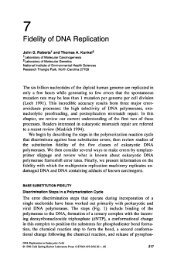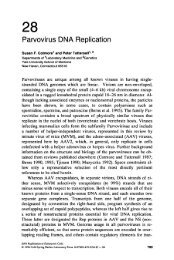Chapter 39: Mitochondrial DNA Replication (PDF)
Chapter 39: Mitochondrial DNA Replication (PDF)
Chapter 39: Mitochondrial DNA Replication (PDF)
Create successful ePaper yourself
Turn your PDF publications into a flip-book with our unique Google optimized e-Paper software.
Mitochondria1 <strong>DNA</strong> <strong>Replication</strong> 1017<br />
These data refined the map positions of these species because of improved<br />
sizing technologies for nucleic acids and were consistent with<br />
previous assignments (Gillum and Clayton 1979). In summary, there are<br />
several sites of likely transition from RNA synthesis to <strong>DNA</strong> synthesis.<br />
For both human and mouse species it is possible, in the majority of cases,<br />
to align RNA 3 ' ends with <strong>DNA</strong> 5 ' ends, consistent with the possibility<br />
that the RNAs are involved in priming replication. In the case of mouse,<br />
a species was isolated that consisted of RNA at its 5' end and <strong>DNA</strong><br />
throughout most of its distal portion (Chang et al. 1985). Importantly, the<br />
5 ' end of the RNA portion of a primed nascent leading strand mapped at<br />
the transcription promoter of this strand. The organization of the genome<br />
is such that all genes served by this promoter lie downstream from the<br />
origin. Thus, in principle, one round of transcription could be sufficient<br />
for a priming event and transcription of all of the genes on this strand.<br />
Initiation of Light-strand Synthesis at the<br />
Lagging-strand Origin<br />
The origin of lagging (L)-strand replication, OL, located well away from<br />
0, (Fig. l), is approximately 30 nucleotides in size. It is interesting that<br />
this small noncoding region is tightly flanked by tRNA genes. The origin<br />
itself has the potential for forming a predictably stable stem-loop structure,<br />
and this feature is highly conserved among sequenced vertebrate<br />
mt<strong>DNA</strong>s, with the exception of chicken (Desjardins and Morais 1990).<br />
Our current understanding of how 0, functions required the development<br />
of an in vitro replication system capable of initiation of L-strand<br />
synthesis that produced nascent strands which were the same as those<br />
that had been previously identified from in vivo mitochondria1 nucleic<br />
acid isolates. The in vitro run-off replication assay (Wong and Clayton<br />
1985a,b) revealed a human mt<strong>DNA</strong> primase with the ability to recognize<br />
0, and initiate priming and <strong>DNA</strong> synthesis. Daughter L-strand synthesis<br />
is primed by RNA synthesis complementary to the T-rich loop structure<br />
of OL. In turn, the transition from RNA synthesis to <strong>DNA</strong> synthesis occurs<br />
near the base of the stem. The site of transition from RNA synthesis<br />
to <strong>DNA</strong> synthesis is contained within an immediately adjacent tRNA<br />
gene. Furthermore, a mutational analysis demonstrated that although the<br />
small OL sequence was necessary and sufficient to support initiation of<br />
<strong>DNA</strong> replication (Hixson et al. 1986), a short pentanucleotide sequence<br />
at the base of the 0, stem was required to maintain a correctly functioning<br />
origin. This appears to involve the ability of mt<strong>DNA</strong> polymerase to<br />
engage a primer, as the mutations examined by Hixson et al. (1986) were






